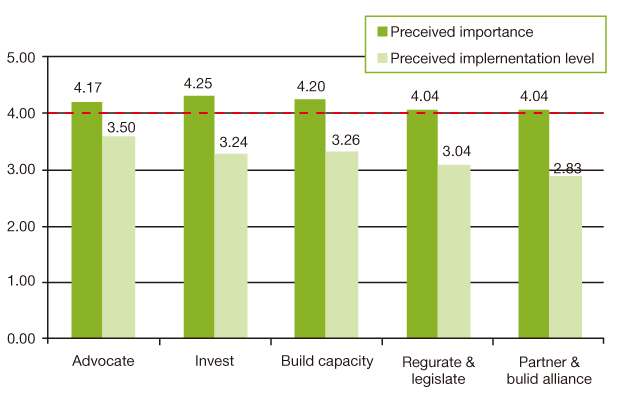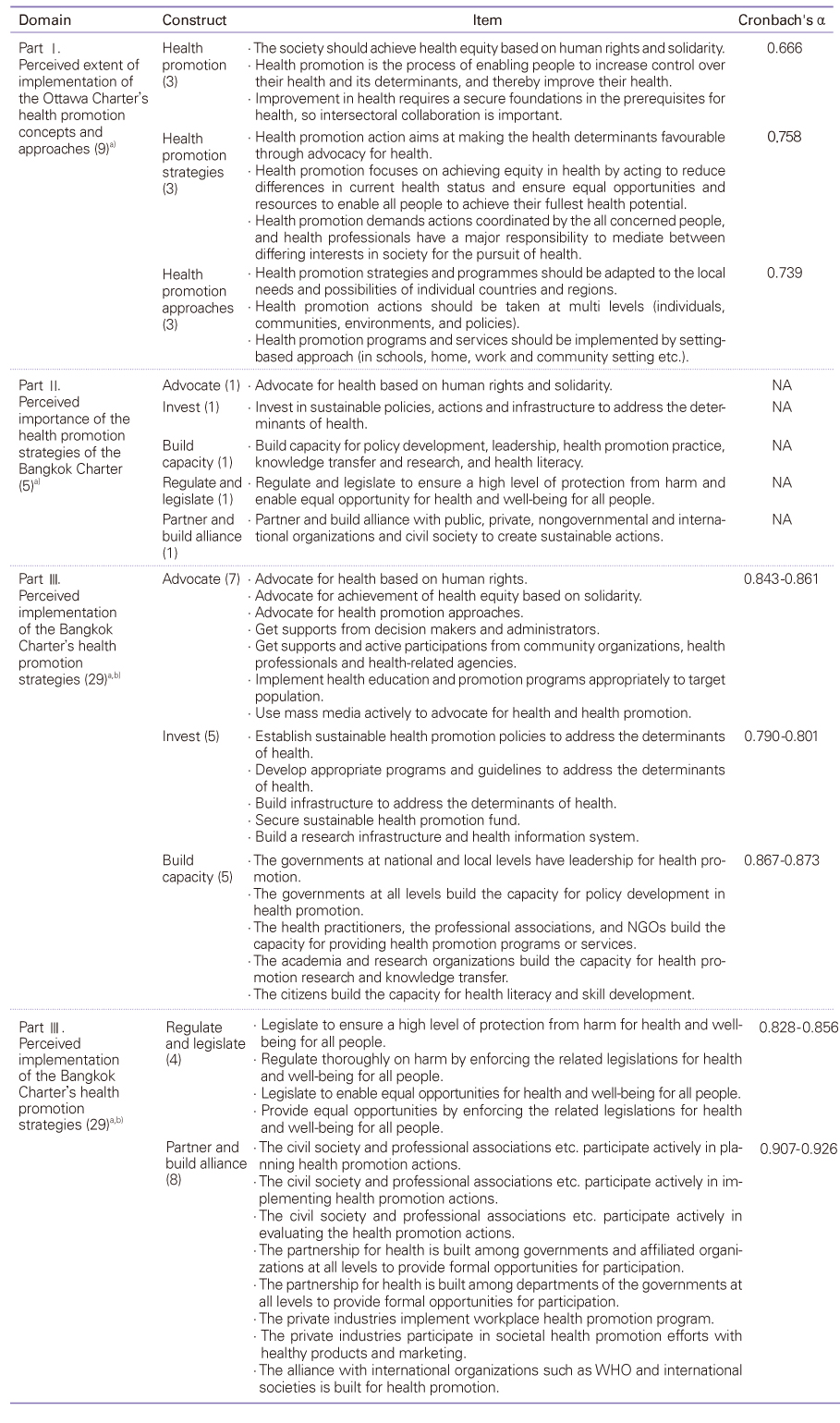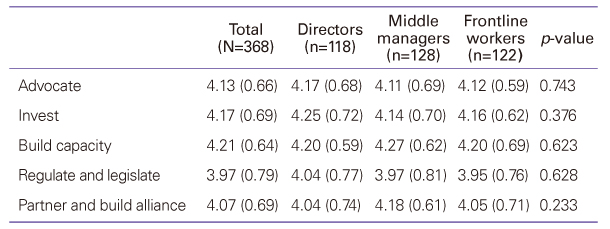2. Health promotion: follow-up to 6th global conference on health promotion (117th Session, Provisional agenda item 9.5.). The report of the World Health Organization Executive Board [Internet]. World Health Organization Executive Board 2006;cited 2011 Jul 15. Geneva: World Health Organization. Available from:
http://apps.who.int/gb/ebwha/pdf_files/EB117/B117_11-en.pdf
3. World Health Organization. The Bangkok Charter. The 6th Global Conference on Health Promotion 2005;Bangkok. World Health Organization.
4. World Health Organization. The Ottawa Charter. The 1st Global Conference on Health Promotion 1986;Ottawa: World Health Organization.
6. Tang KC, Beaglehole R, O'Byrne D. Policy and partnership for health promotion: addressing the determinants of health. Bull World Health Organ 2005;83:884.
7. McMichael AJ, Butler CD. Emerging health issues: the widening challenge for population health promotion. Health Promot Int 2006;21:Suppl 1. 15-24.
8. Lee K. Global health promotion: how can we strengthen governance and build effective strategies? Health Promot Int 2006;21:Suppl 1. 42-50.
9. Fidler DP. Health as foreign policy: harnessing globalization for health. Health Promot Int 2006;21:Suppl 1. 51-58.
10. Jackson SF, Perkins F, Khandor E, Cordwell L, Hamann S, Buasai S. Integrated health promotion strategies: a contribution to tackling current and future health challenges. Health Promot Int 2006;21:Suppl 1. 75-83.
11. Regional framework for health promotion 2002-2005 [Internet]. World Health Organization Regional Office for the Western Pacific 2002;cited 2011 Jul 15. Manila: World Health Organization Regional Office for the Western Pacific. Available from:
http://www.wpro.who.int
14. Catford J. The Bangkok Conference: steering countries to build national capacity for health promotion. Health Promot Int 2005;20:1-6.
15. Mittelmark MB, Wise M, Nam EW, Santos-Burgoa C, Fosse E, Saan H, Hagard S, Tang KC. Mapping national capacity to engage in health promotion: overview of issues and approaches. Health Promot Int 2006;21:Suppl 1. 91-98.
16. Foster-Fishman PG, Berkowitz SL, Lounsbury DW, Jacobson S, Allen NA. Building collaborative capacity in community coalitions: a review and integrative framework. Am J Community Psychol 2001;29:241-261.
17. Labonte R, Woodard GB, Chad K, Laverack G. Community capacity building: a parallel track for health promotion programs. Can J Public Health 2002;93:181-182.
18. Raeburn J, Akerman M, Chuengsatiansup K, Mejia F, Oladepo O. Community capacity building and health promotion in a globalized world. Health Promot Int 2006;21:Suppl 1. 84-90.
22. A strategic approach to community health improvement: MAPP-field guide [Internet]. National Association of Country and City Health Officials (NACCHO) 2002;cited 2011 Jul 15. Washington DC: NACCHO. Available from:
http://www.naccho.org
23. Green LW, Kreuter MW. Health promotion planning: an educational and ecological approach 2005;4th ed. New York: McGraw-Hill Humanities.
24. Wise M. Building capacity to promote health at national and local levels: after the Bangkok Charter about globalization, policy and partnerships. Korean Society for Health Education and Promotion. 2005 International Symposium Proceedings 2005 Sep 23-24. Seoul, Korea: 33-51.
25. Tang KC, Beaglehole R, Pettersson B. Implementation of the Bangkok Charter on Health Promotion in a Globalized World: experience and challenges of selected high income countries in Europe. Soz Praventivmed 2006;51:254-256.
26. Mittelmark MB. Shaping the future of health promotion: priorities for action. Health Promot Int 2008;23:98-102.
27. A strategy for health promotion in the Eastern Mediterranean region [Internet]. World Health Organization Regional Office for the Eastern Mediterranean 2008;cited 2011 Jul 15. Cairo: World Health Organization Regional Office for the Eastern Mediterranean. Available from:
http://www.wpro.who.int
28. Lee JK, Jung TR. The current situation and strategies of health promotion practice in Korea. Proceedings of the Spring Conference of the Korean Society for Preventive Medicine in 2005 2005;2005 May 13. Seoul, Korea: Seoul: The Korean Society for Preventive Medicine.
29. Korea Institute for Health and Social Affairs. Establish of new health plan 2010 2006;Seoul: Korea Institute for Health and Social Affairs.
30. Ministry of Health and Welfare. The 3rd National Health Plan (2011-2020) 2011;Seoul: Ministry of Health and Welfare.
31. Lee MS, Kim JR, Park MS, Kang MJ. Guidelines and approaches to facilitate the implementation of health promotion strategies of the Bangkok Charter in Korea 2006;Suwon: Sungkunkwan University School of Medicine.
32. Lee MS, Kim JR, Park MS, Kang MJ. Guidelines to facilitate the implementation of health promotion strategies of the Bangkok Charter in Korea. Paper presented at: The vision and practice of the national health promotion practice 2007 Spring Conference of The Korean Society for Health Education and Promotion. 2007 May 27-28. Daegu, Korea.
33. National Health Promotion Act of 1995, Stat. 10327 (May 27, 2010) [Interent] cited 2011 Jul 15. Seoul: Ministry of Goverment Legislation. Available URL:
http://www.law.go.kr/main.html
34. Child Dietary Life Safe Control Special Act 2008, Stat. 10513 (Mar. 21, 2009) [Interent] cited 2011 Jul 15. Seoul: Ministry of Goverment Legislation. Available URL:
http://www.law.go.kr/main.html
35. The power to reduce health disparities: voices from REACH communities [Internet]. Centers for Disease Control and Prevention 2007;cited 2011 Jul 15. Atlanta: US Department of Health and Human Services, Centers for Disease Control and Prevention. Available from:
http://www. cdc.gov/reach
36. Building a healthier Alberta: one community at a time (2005-2010 report). [Internet]. Healthy Alberta Communities c2005-2010;cited 2011 Jul 15. Edmonton: University of Alberta, School of Public Health, Centers for Health Promotion Studies. Available from:
http://www.healthyalbertacommunities.com
37. Raine KD, Plotnikoff R, Nykiforuk C, Deegan H, Hemphill E, Storey K, Schopflocher D, Veugelers P, Wild TC, Ohinmaa A. Reflections on community-based population health intervention and evaluation for obesity and chronic disease prevention: the Healthy Alberta Communities project. Int J Public Health 2010;55:679-686.
38. Seoul Medical Center. Current status and prospects of the health promoting hospital. Proceedings of the Seoul Medical Center International Conference 2010 2010 Nov 1. Seoul, Korea: The Korea Chamber of Conference & Industry.
39. Pelikan JM, Krajic K, Dietscher C. The health promoting hospital (HPH): concept and development. Patient Educ Couns 2001;45:239-243.
40. Cho HJ, Sunwoo S, Song YM. Attitudes and reported practices of Korean primary care physicians for health promotion. J Korean Med Sci 2003;18:783-790.















